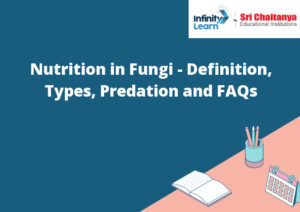Table of Contents
Nutrition in Fungi – Definition, Types, Predation and FAQs
Nutrition in Fungi – Definition
Fungi are a group of organisms that are in the kingdom Fungi. This kingdom includes mushrooms, molds, and yeasts. Fungi are eukaryotic and heterotrophic. This means that they have a nucleus in their cells and that they get their food by eating other organisms.

Explain Nutrition in Fungi
Fungi are eukaryotic organisms that lack chlorophyll and depend on other organisms for their nutrition. Fungi secrete digestive enzymes that break down the food into simple molecules that can be absorbed through the cell wall. The absorbed molecules are used to produce energy and to build new cells.
Types of Nutrition in Fungi
There are three types of nutrition in fungi:
1. Saprophytic Nutrition: This type of nutrition is obtained by the absorption of food from dead or decaying organic matter.
2. Parasitic Nutrition: This type of nutrition is obtained by the absorption of food from living organisms.
3. Holozoic Nutrition: This type of nutrition is obtained by the ingestion of food particles.
Saprotrophic Fungi
Saprotrophic fungi are a type of fungus that lives off of dead or decaying organic matter. They break down the organic matter into simple molecules that they can absorb and use for energy and growth.
Saprotrophic fungi can play an important role in the decomposition of organic matter and the recycling of nutrients back into the environment.
Parasitic Fungi
Parasitic fungi are those fungi that live in or on other organisms, usually plants, and derive their nutrients from them. Many parasitic fungi are serious plant pathogens that can cause extensive damage to crops.
Some parasitic fungi are also human pathogens, causing diseases such as histoplasmosis, blastomycosis, and coccidioidomycosis.
Parasitic Fungi in Humans
Parasitic fungi are a type of fungus that lives in or on another organism in a parasitic relationship. This means that the fungus benefits from the relationship while the other organism is harmed. Parasitic fungi can cause a variety of diseases in humans, including
- Candidiasis, a fungal infection of the mouth, throat, or genitals
- Cryptococcosis, a fungal infection of the lungs
- Aspergillosis, a fungal infection of the lungs, brain, or heart
- Blastomycosis, a fungal infection of the lungs
- Histoplasmosis, a fungal infection of the lungs
- Parasitic fungi can be spread through the air, soil, or water. They can also be spread through contact with an infected animal or person.
Symbiotic Fungi
A symbiotic fungus is a fungus that lives in close association with another organism, which can be a plant, another fungus, or an animal. The symbiotic relationship can be mutualistic, in which both organisms benefit, or parasitic, in which one organism benefits at the expense of the other.
In many cases, the symbiotic relationship is essential for the survival of one or both of the organisms involved.
Predation
The primary predator of the desert iguana is the rattlesnake.
- The desert iguana has a number of adaptations that help protect it from predation, including its coloring, its behavior, and its habitat.
- The desert iguana’s coloring helps it to blend in with its surroundings, making it difficult for predators to see it.
- The desert iguana’s behavior helps to protect it from predation. It is a very fast runner, and it can also climb trees to escape predators.
- The desert iguana’s habitat also helps to protect it from predation. Its habitat is full of rocks and crevices that the iguana can hide in if necessary.

